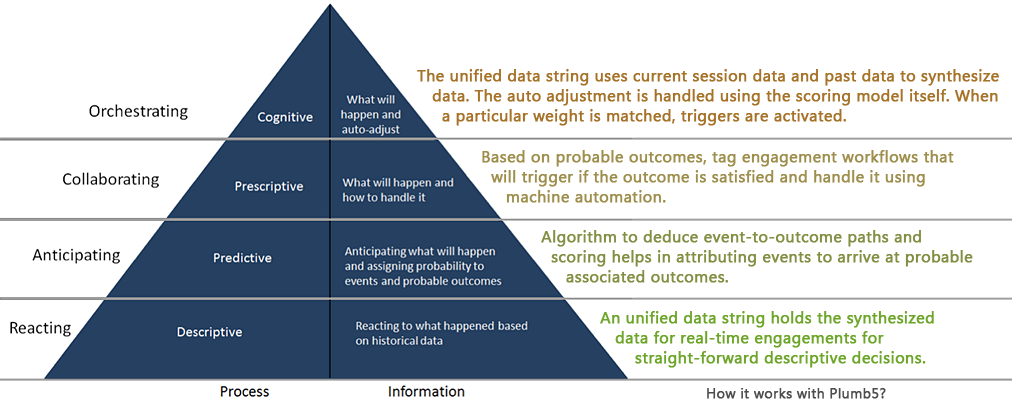Businesses are looking to scale beyond descriptive and predictive analytics apps by finding analytics platforms capable of propelling to the upper levels of the Intelligence Maturity Model.
According to SelectHub’s Selecting the Best Cloud Analytics Platform, Majority of companies today are locked in the lower layers of the Intelligent Cloud Maturity Model. Using analytics apps that only deliver descriptive analytics is like trying to drive forward by staring in the rearview mirror.Enterprises need to push analytics platform providers to develop and launch machine learning, advanced prescriptive and cognitive analytics. When this happens, companies will be able to see how the timing of a decision during a given financial period makes a major difference in outcomes.Best of all, there will less guessing and more knowing about why a given strategy or business model is succeeding or not.

Here is a run down on what makes Plumb5 the right platform to orchestrate your customer-driven processes.
The customer string
Plumb5 uses a proprietary data structure to handle customer data. The data structure is unique by its customer-centric structure which holds relation to every customer attribute covering cross-channel behavior and interactions. Sequenced by time, it creates absolute customer journeys, which reveals purchase and affinity patterns. When configured, these patterns are stored with state-level tags for quick match outputs, useful for computing in real-time.
When the marketer specifies a particular outcome, data can be pivoted at the outcome event and resulting patterns can be extracted that influence the specified outcome. Goal paths and Reverse Goal paths can be used to understand the influence of a specific event to the desired outcome.
Real-time Scoring
The patterns consist of multiple events and deviations are true at every event of the customer journey. These deviated patterns between stages of the journey reveal user’s intent and drag towards a particular outcome. It is important to identify the intent of the customer at a certain stage to determine the probability of reaching the outcome.
The event-based scoring mechanism allows in calculating the intent of a particular user in real-time or attributing a probability score to create autosegments or suggest the shortest possible path to the desired outcome.
Real-time Automation
Based on scores and state tags, triggers can be configured to automate engagement with customers based on desired outcomes at every stage of the customer journey.
You can cascade triggers for every event responses and automate most of the customer communication processes, across the customer lifecycle.
Incorporating Cognitive Parameters
Wondering if the machine is cognitive enough to auto-adjust decisions based on cognitive inputs like images, voices or text conversation?. Yes, you can achieve incorporating cognitive tags to the customer string which can be used to synthesize and output the decision for next action.
Be it an image profile or product type or color or contexts in a conversation, data is extracted and stored as tags for consumption during computation or during an engagement. For instance, if the customer affinity towards a Red Nike shoes is evident due to repeat interactions, the tags “red” “nike” “shoes” are stored as tags which can be consumed either during personalized messaging or during a bot based chat session.
Machine Learning
Plumb5 can be classified under the category of supervised learning, where macro-level outcomes can be set and the machine can generate the possible paths and their weights that lead to the outcome. It can be configured to learn and store the most probable answer for automating the next action. It can be customized to include automated multivariate testing to arrive at the probable answer that is tested by the real audience.
The core objective of any business would be to achieve customer satisfaction and business profitability, wherein profitability is the resultant of customer satisfaction. Businesses can implement Plumb5 to meet their core objectives through machine learning and decision automation.
